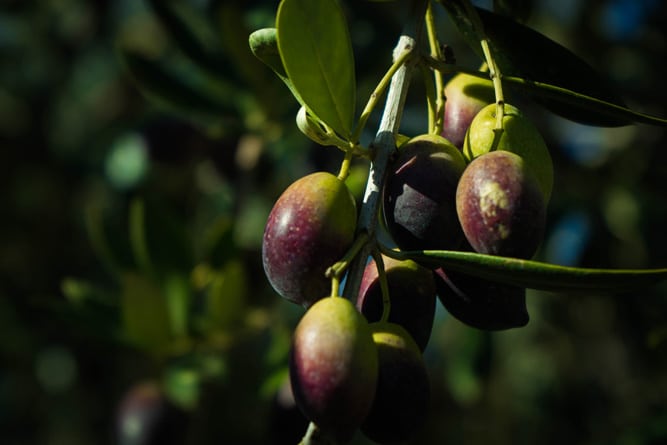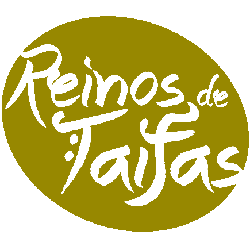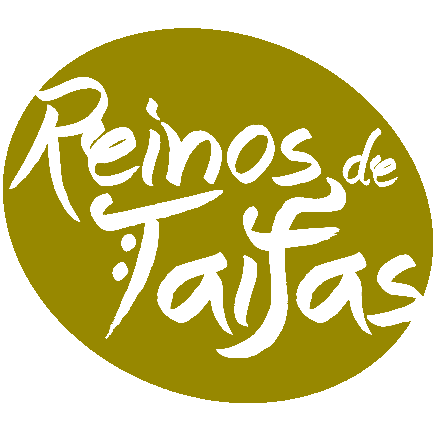When does the olive harvest take place?
The olive harvest takes place once a year. The olive harvest season starts in the last quarter of the year (between October and December). The olive harvest begins when the olive is at its optimal ripeness.
The weather is fundamental to the olives development along the year. Our olive trees are in the South of Spain (Andalusia), and here the rainfall may vary drastically, from not enough water to excess of rain causing floods. Extreme temperatures (both hot and cold), the hail, blight and olive tree illnesses and lack of nutrients could affect the olive development. Read more about our sustainable farming.
How do we know when it is the right moment to start the olive harvest?
To be able to determine the exact moment to start the olive harvest we have to pay attention to factors like the olives size, shape, and colour. It is common to find in the same branch of an olive tree that there are olives of a different colour. It is not an easy decision to make. Experience is a crucial factor to know whether the olives are ready or not to harvest.
The olives are green at first, and then over time, they become gradually dark purple, going through other tonalities. The perfect moment of ripeness is known as “envero”, and is when the olive goes from strong green colour to green-yellow and after to a violet colour.

Extra virgin olive oil quality
Depending on when you do the olive oil harvest the quality of the olive oil could be:
1. Early olive harvest: when the olive harvest takes place early, the virgin olive oils obtained are higher quality, but the olive yield is going to be lower. That is because the olive contains more water when harvested early and therefore the olive oil represents less percentage of the olive weight. The olive oils produced with these olives harvested early are more expensive than the late olive harvest virgin olive oils.
2. Late olive harvest: when the olive harvest takes place later the olives are going to lose weight by reducing their amount of water. That means that the yield is going to be higher. On the other hand, the olive oil obtained is lower quality. All the olive oils obtained are virgin olive oils, but not all of them are extra virgin. Acidity grade is going to increase because of the degradation of the olives with time.
Are all the virgin olive oils the same?
Once the olive harvest season starts, you can only work the days that it is not raining. Depending on the number of olive trees you need more or fewer days to do the olive harvest. When you leave it too long, the olives tend to fall off the branches. That is going to make the olive harvest more difficult, and it is going to reduce the quality of the olive oil obtained. The olive oils produced at the beginning and the end of the olive harvest season are of a different class. That happens even when the olives come from the same area and olive tree cultivar.
Reinos de Taifas positioning
In Reinos de Taifas we firmly believe that quality comes before quantity always. We pursue excellence to differentiate us from other companies that have been more focused on offering a low price (by sacrificing product quality).
- We harvest the olives early
- Grind the olives of our olive trees freshly collected from the fields
- The only time that elapses is to transport to our olive mill
- The olive preserves its qualities intact
- Obtaining a high-quality, premium extra virgin olive oil (EVOO)
Our target is to provide access to a high-quality extra virgin olive oil, produced from beginning to end with pride. We want many people to benefit from our healthy and tasty extra virgin olive oils. That’s why we adjust our margin to the minimum to be able to offer competitive prices. Learn more about our ‘Green Gold’.
Why extra virgin olive oils have different colours?
The characteristic green colour of the extra virgin olive oils (EVOO) is due to the content of chlorophyll that gives a green colour to the olives. Chlorophyll content is higher when the harvest of the olives takes place in the early harvest. People tend to consider the colour as a quality indicator in the olive oils. It is important to note that different olive cultivars may have different amounts of chlorophyll. Colour is not the best indicator of the quality of extra virgin olive oil. Measuring acidity level, professional taste, and chemical analysis are legal requirements to label a virgin olive oil as extra virgin olive oil. Read more about our ‘Single Variety’ extra virgin olive oils.
How is the olive harvest done?
– Traditional olive cultivation
In traditional olive cultivation, the olive trees are separated from each other by significant distances (also known as frames). In the past, the frames used to be 14×14 metres (46×46 feet) with olive trees of 3 or four trunks. The olive tree fields were used to feed and grow animal stock. Later the frames were decreased in size to the 7×7 metres (23×23 feet) that we can find today in the new plantations.
The olive harvest in the traditional olive cultivation is going to depend on the land characteristics. Depending on the terrain the cultivars could be mechanised or not mechanised. In the non-mechanized olive tree cultivation, the olives fall by hitting the branches of the olive trees.
In the mechanised olive tree cultivation, you can use machinery to make the olive tree trunk vibrate (when the olive tree allows it) at the same time that you hit it from the outside. That machine is usually attached to a tractor. With the vibration, the damage and the stress to the olive tree are reduced compared to when hitting it exclusively. Vibration is also more efficient and faster. The olives are collected with canvases when they fall to the floor. Some tractors have attached “inverted umbrellas” to collect the olives while vibrating the olive tree as we can see in the following video.
– Intensive olive cultivation
The intensive olive cultivation differs from the traditional because it uses smaller frames (8×4 or 6×5 metres) (26×13 or 20×16 feet). That means you can plant more olive trees on the same surface. The olive harvest is like in the traditional olive cultivation.
– Super-intensive olive cultivation
In the super-intensive olive cultivation, the olive trees grow in lines. The frames are 5×2, 5×1.5 or 5×1 metres (16×6.5, 16×5 16×3 feet). That allows planting 1000 to 2000 olive trees in one hectare (2,5 acres). In super-intensive olive cultivation, a harvester machine collects the olives. Here you can see an example of a harvester that works in super-intensive olive cultivation.
How much olive oil we obtain in the olive harvest
Depending on the age and the size of the olive tree the production per olive tree could vary regarding the number of olives and their yield. Also, factors such as the cultivation type (traditional, intensive or super-intensive), and the light that the olive tree leaves receive are going to influence the olive production. It is important to note that the olive tree cycle takes two years, alternating one big harvest with a smaller one. It is also going to depend on the field being watered artificially or only with the rainwater.
The yields could be between 15% and 30% of the fruit weight. In the traditional olive tree cultivation, an olive tree could produce between 20 and 50 kg of olives in one trunk olive trees. That means 5-10 litres of virgin olive oil per olive tree per year. Old olive trees with two or three trunks could produce up to 100 kg of olives per olive tree in a good year.
First olive oils or early-harvest extra virgin olive oils
The first olive oils collected each year are the ones of the highest quality, and they are considered premium extra virgin olive oils. They have an intense, fresh flavour. Once we obtain the extra virgin olive oil, we leave them quiet to let the suspended particles go gradually to the bottom and that way the olive oil is going to be more transparent with time.
Cold extraction exclusively by mechanical means
To consider an olive oil extra virgin it can only be made by mechanical procedures. These procedures include the blending, centrifugation and filtration. To classify an olive oil as extra virgin, we can´t add anything, and we can´t apply heat on it either. When we talk about cold extraction in olive oil is because the temperature is low when blending and during centrifugation to avoid that the olive oil loses organoleptic properties and to keep it fresh.
Extra virgin olive oil. Filtered or not filtered?
After obtaining the EVOO, it is possible to filter it or not. Filtering the extra virgin olive oil means that the olive oil is going to be more stable and it is going to last longer. If we do not filter the olive oil, we obtain a healthier extra virgin olive oil with a higher content in micronutrients with antioxidant, anti-inflammatory properties and other health benefits and a stronger and fresher taste. The only downside of unfiltered olive oils is that their “best before” date is shorter than the filtered olive oils. Still, this process is slow and could take several months. Unfiltered extra virgin olive oils are considered better for adding to foods raw and filtered EVOO are also used for cooking.
Monovarietal extra virgin olive oil. ‘Single Variety’
When you want to produce an extra virgin olive oil that is 100% monovarietal or ‘Single Variety’ you have to plan it from planting the olive trees until the bottling of the EVOO.
- Planting the olive trees: plant each cultivar in different areas
- The olive harvest: harvest every single variety exclusively
- Grinding the olives: avoid mixing with other cultivars in the mill
- Storage: the single varieties in separate containers
- Testing: of every ‘Single Variety’ extra virgin olive oil batch
- Bottling and labelling: of each monovarietal. More references to handle
Read more about our ‘Single Variety’ extra virgin olive oils
Do an extra virgin olive oil tasting at home with family and friends
All these efforts are worthwhile when you try the outcome. Appreciate the different nuances of the monovarietal extra virgin olive oils in a tasting allows you to choose your favourite ‘Single Variety’. To make it easier for you we have designed our product “Cata pack”, with six different ‘Single Variety’ extra virgin olive oil bottles for tasting. Try them all at the same time and discover your favourite olive oil to use at home or to gift to your beloved ones. Live an unforgettable experience with our product “Cata pack”.
Conclusion
The olive harvest takes place once a year, in the winter months. The olive harvest starts when the olives are at their perfect moment of ripeness, known as “envero”. The best extra virgin olive oils are the early harvest ones when the olive is at its best. It is always better to prioritise quality over quantity, and that´s how we do it at Reinos de Taifas.
The green colour can make olive oils look nice, but that´s not the best indicator of the quality of an extra virgin olive oil. It is more trustworthy to measure the acidity level and do the appropriate tests. The best option is always to buy from a trusted olive oil producer. Read more about our products in our online shop.
Thank you for reading till the end. If you liked the article and you want to receive by email the new ones that we write in the future, please subscribe to our email list by clicking in the envelope on the top right corner. If you have any queries about the olive harvest or related to the extra virgin olive oil ask in the comments section. Don´t forget to share this article with your friends on social media!



So interesting 👌
Thank you Javier! We are glad you found the article interesting 🙂